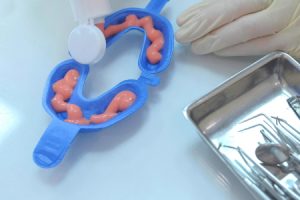
What is Topical Fluoride?
We classify fluoride into two categories, depending on the method of delivery. These include topical fluoride (applied directly to tooth surface) and systemic fluoride (ingested and absorbed by the body via the food and water we eat and drink).
The surface of your teeth might seem like a stable, unchanging environment, but on a molecular level, tooth enamel experiences minor damage and erosion every day. However, the good news is that tooth enamel is also constantly rebuilding and repairing itself, a process called remineralization.
During a dental checkup and cleaning, we might recommend a topical fluoride treatment. (You probably remember this procedure from your childhood, but adults can benefit as well, especially if they are at higher risk for cavities.) We use a fluoride solution to fill a mouthpiece, and you wear it over your teeth for about 4 minutes. Introducing fluoride to the remineralization process helps strengthen the enamel, making each tooth more resistant to developing cavities.
After a topical fluoride treatment, you should avoid eating or drinking anything for at least 30 minutes. This allows the residual fluoride to continue to absorb into the tooth surface.
For those at an increased risk of cavities, we may also recommend a fluoridated toothpaste or rinse for at-home use. During an appointment, be sure to ask your dentist for a recommendation, and we’ll be happy to discuss your home-care options.
What about systemic fluoride?
For children and their newly-forming teeth, fluoride is an effective way to make teeth more resistant to cavities.
Many municipalities add a small amount of fluoride to the water supply to boost systemic fluoride. Other individuals, especially households with young children or who rely on bottled or well water, might benefit from fluoride supplements.
Once adult teeth are fully formed, both systemic and topical fluoride is helpful to maintain health and prevent cavities.
